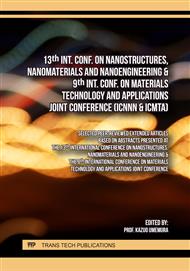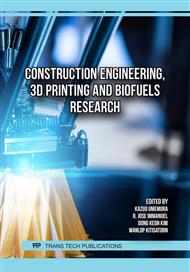[1]
X. Wang, H. Li, T. Wang, X. Niu, Y. Wang, S. Xu, et al.: Flexible and high-performance piezoresistive strain sensors based on multi-walled carbon nanotubes@polyurethane foam, RSC Advances
DOI: 10.1039/d2ra01291j
Google Scholar
[2]
J. Wang, Y. Lou, B. Wang, Q. Sun, M. Zhou and X. Li: Highly Sensitive, Breathable, and Flexible Pressure Sensor Based on Electrospun Membrane with Assistance of AgNW/TPU as Composite Dielectric Layer, Sensors
DOI: 10.3390/s20092459
Google Scholar
[3]
H. Jiang, Y. Zhang, R. Zhou, L. Meng, C. Pan, W. Mai, et al.: Recent advances of wearable and flexible piezoresistivity pressure sensor devices and its future prospects, Journal of Materiomics
DOI: 10.1016/j.jmat.2020.01.009
Google Scholar
[4]
J.-C. Shang, H. Yang, G.-Q. Hong, W.-H. Zhao and Y.-F. Yang: Flexible pressure sensor enhanced by polydimethylsiloxane and microstructured conductive networks with positive resistance-pressure response and wide working range, Composites Part B: Engineering
DOI: 10.1016/j.compositesb.2023.110931
Google Scholar
[5]
S. Bhandari, Krishnanand, A. Singh and M. Taufik: 3D printing methods and materials for sensor fabrication, Materials Today: Proceedings
DOI: 10.1016/j.matpr.2023.06.146
Google Scholar
[6]
So, H. and J. Lee: 3D-printing-assisted flexible pressure sensor with a concentric circle pattern and high sensitivity for health monitoring, Microsystems & Nanoengineering, http://dx.doi.org /
DOI: 10.21203/rs.3.rs-1975150/v1
Google Scholar
[7]
P. Kungsadalpipob, M.-M. Lubna and P.-D. Bradford: Novel three-dimensional printed continuous Zylon yarn reinforced polylactic acid composites utilizing compatible sizing, Progress in Additive Manufacturing
DOI: 10.1007/s40964-023-00549-x
Google Scholar
[8]
J. Yan, A. Chen and S. Liu: Flexible sensing platform based on polymer materials for health and exercise monitoring, Alexandria Engineering Journal
DOI: 10.1016/j.aej.2023.11.085
Google Scholar
[9]
C. Liu, N. Huang, F. Xu, J. Tong, Z. Chen, X. Gui, et al.: 3D Printing Technologies for Flexible Tactile Sensors toward Wearable Electronics and Electronic Skin, Polymers, https://doi.org /
DOI: 10.3390/polym10060629
Google Scholar
[10]
M. Imanian, M. Kardan-Halvaei, F. Nasrollahi, A. Imanian, H. Montazerian and V. Nasrollahi: 3D printed flexible wearable sensors based on triply periodic minimal surface structures for biomonitoring applications, Smart Materials and Structures
DOI: 10.1088/1361-665X/aca6bc
Google Scholar
[11]
N. Poompiew, P. Pattananuwat, C. Aumnate, A. J. Román, T. A. Osswald, and P. Potiyaraj: 3D printable resin/carbon nanotube composites for wearable strain sensors: Enhancing mechanical and electrical properties, Journal of Science: Advanced Materials and Devices, https://doi.org /
DOI: 10.1016/j.jsamd.2023.100546
Google Scholar
[12]
I. Jung, E. Shin and S. Lee: Study on CNT/TPU cube under the 3D printing conditions of infill patterns and density, Scientific Reports
DOI: 10.1038/s41598-023-44951-5
Google Scholar
[13]
B. Li, W. Liang, L. Zhang, F. Ren and F.-Z. Xuan: TPU/CNTs flexible strain sensor with auxetic structure via a novel hybrid manufacturing process of fused deposition modeling 3D printing and ultrasonic cavitation-enabled treatment, Sensors and Actuators A: Physical, https://doi.org /
DOI: 10.1016/j.sna.2022.113526
Google Scholar
[14]
R. Yu, T. Xia, B. Wu, J. Yuan, L. Ma, G. Cheng, et al.: Highly Sensitive Flexible Piezoresistive Sensor with 3D Conductive Network, ACS Applied Materials & Interfaces, http://dx.doi.org /
DOI: 10.1021/acsami.0c09552
Google Scholar
[15]
N. Shadvar, E. Foroozmehr, M. Badrossamay, I. Amouhadi and A. Shojaei: Computational analysis of the extrusion process of fused deposition modeling of acrylonitrile-butadiene-styrene, International Journal of Material Forming, https://link.springer.com/article/
DOI: 10.1007/s12289-019-01523-1
Google Scholar
[16]
S. Gu, J. Ma, L. Kang, H. Wei, L. Jiang and L. Wang: Effect of heat treatment on the performance of 3D printed thermoplastic polyurethane flexible substrates, Journal of Applied Polymer Science
DOI: 10.1002/app.53741
Google Scholar



